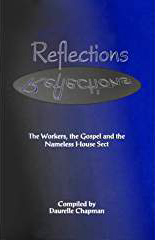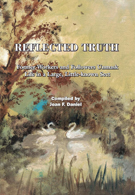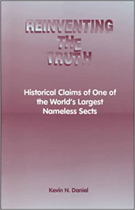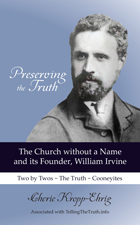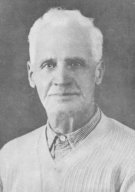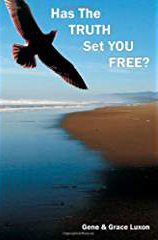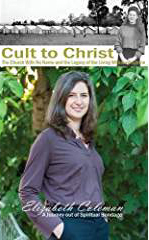Edward Cooney’s Family Background
By Seamas Mac Annaidh
aka Seamas McCanny
Printed in The Fermanagh Miscellany 2
Compiled by Fermanagh Authors' Association, Enniskillen, N. Ireland, 2008
On the 20 June 1960 in Mildura, Australia an old man passed away. He was in his 94th year having been born in Enniskillen 11 February 1867. His name was Edward Cooney and he had been travelling, preaching, for over sixty years. During that time he had known no permanent home as he had turned his back on material possessions. His story has been well told by Patricia Roberts in her 1990 book The Life and Ministry of Edward Cooney 1867-1960. Many older residents of Enniskillen will remember seeing and hearing him preaching at the Diamond, just around the corner from where he was born at 4, High Street. Edward Cooney was a man both revered and ridiculed and must surely have been the most influential and controversial religious figure ever to come from Enniskillen.
Not that Enniskillen had not seen its share of religious controversy.
‘This town is split into sects - religious, political and social - beyond any place I ever knew of.’ So wrote the newly appointed rector of Enniskillen, Rev. William Connor Magee, to a friend in 1861. ‘My chief difficulty,’ he explained, ‘has been the necessity, or supposed necessity, of conciliating the Primitive Methodists; by far the largest body here, who call themselves Churchmen, and who certainly are most of them communicants, and who hate the Wesleyans with a perfect hatred, but who nevertheless require some delicate attention on our part to keep them with us.’
Dr. Magee lived at Chanterhill 1861-64 and was an active and energetic clergyman, and much involved in local society. He was much esteemed as a preacher and would eventually become archbishop of York. Although Irish by birth, indeed his grandfather, Archbishop William Magee of Dublin had been born in Enniskillen, he spent most of his ministry in England and his couple of years in Enniskillen were intended as a break from city life. He seems to have found Enniskillen a refreshing challenge.
On August 31 1863 Dr. Magee conducted the marriage ceremony of William Rutherford Cooney to Emily Carson. W. R. Cooney (1836-1924) had come to Enniskillen from Cootehill, Co. Cavan and just like his contemporary Anthony Cassidy who came from Dowra, he served his time with a local businessman, married his daughter and eventually succeeded him. W. R. Cooney’s wife, Emily was the only child of William Carson, a prominent Enniskillen business man who was also Chairman of the Enniskillen Town Commissioners. William Carson was a Methodist whose wife Mary was a daughter of Enniskillen saddler, William Quinton, a Presbyterian. [Click Here to View Photos of Cooney Family]
William Carson (1816-1900) was a native of the Letterbreen district and it is probable that he too also served his time and learned his trade with an Enniskillen shopkeeper, probably Terence Ingoldsby, whom he succeeded, and in July 1850 he moved across High Street to No. 4, the Hibernian House, where he succeeded George Kittson and Liddle Baxter. The Hibernian Monster House, as it was sometimes called, was a great clothes emporium and it remained a highly successful business under W. R. Cooney. The site is now Graham’s Menswear, but the original more impressive building was destroyed by a bomb which devastated the town centre in the 1970s.
A prominent Methodist William Carson held two pews in the gallery of the old preaching house in Wesley Street, and was a regular attender at the new church in Darling Street from its opening in 1867.He had been an active class leader; he had filled the office of pew steward, and was a generous giver to the church funds. It was said that if the congregation fell into debt Mr. Carson was always one of ‘the reliables.’ In 1887 William Carson had the honour of performing the official opening ceremony of Florencecourt Methodist Church and he was accompanied by his grand-daughter Miss Cooney.
William Carson was well-known for his opposition to the drink trade, especially when he sat on the Bench at Enniskillen Petty Sessions.Yet when the famed local poteen maker Gerard Howden was down on his luck in his latter years William Carson happily subscribed a gold sovereign to a collection that was being made for him. He was also one of the Governors of the County Infirmary in which he took a special interest, and was a member of the Protestant Board of Education at Portora, which he attended constantly.
Although Mary Quinton, his wife would not have had the same opportunities to become involved in public life she also seems to have been a strong personality and to have been actively involved in the running of the family business. When she died in 1892 the Impartial Reporter remarked:
‘Mrs. Carson had reached a ripe old age, and even in late years as well as long ago when with her husband she founded a large and prosperous business she preserved her gracious and courteous manner and those traits of character which made her much esteemed. She was a member of one of the old Enniskillen families, the Quintons, and had a ‘long’ memory of all things pertaining to Enniskillen. In later years she was necessarily obliged to keep more indoors, and was unable to mix freely, as she had once done, with her friends; but she was cheery and light to the last.’
The ‘long’ memory referred to probably relates to the history of Enniskillen, not just to the town and its people but to its role in the events of 1689-90. The implication is that Mary Quinton Carson was a staunch loyalist.
The Carsons lived in retirement in Willoughby Place and their graves are at Rossorry Parish Church. The Cooneys then lived nearby at Lakeview House. Undoubtedly Edward Cooney would have been in regular and close contact with his grandparents through his formative and early adult years.
Edward Cooney was brought up as a member of the Church of Ireland but his family background, and Dr. Magee’s remark about the fragmented nature of the Protestant community in Enniskillen at that time, both suggest that he came under a bewildering array of influences.
W. R. Cooney and his wife Emily Carson had eight children, of whom Edward was the third, born in 1867. This date is significant for it means that the claim made later by Cooney himself that he had been baptised, or as he put it, ‘sprinkled with water,’ by Dr. Magee cannot be correct, since Dr. Magee had left Enniskillen three years before his birth. Edward Cooney was very much opposed to institutional religion and was renowned for his forceful and colourful use of language, especially when it came to denouncing clergymen of different denominations. He would surely have been particularly pleased to be able to claim that not even the famed Dr. Magee had given him a true baptism. Baptism by total immersion became a noted part of the doctrine Cooney preached and his followers were often referred to as ‘the Dippers’ for this reason.
Edward’s father, William Rutherford Cooney, was an active member of the Church of Ireland and a successful businessman. He was prominent in protests made by the congregation in the 1880s when they perceived a trend towards ritualism and Romanism in the church services.
Edward attended Enniskillen Model School under the Catholic headmaster Charles Morris and Portora under the Rev. William Steele. A contemporary of his at the Model later remarked ‘Eddie ... was one of the nicest, and best behaved boys in the school. Harry was the wildest during my time.’ (IR 26 January 1922). The six Cooney boys must have been a noticeable presence in the school.
On leaving school the young Edward was sent to Armagh where he was apprenticed to a Presbyterian businessman. It was in Armagh at the age of 17 he was ‘born again’ but it was not until 1901 when he was 34 that he that he made the decision to turn his back on the world of commerce and became a full-time travelling preacher, much to his father’s dismay. By this time he had experienced many changes in his life and had spent time in Australia.
His early life was clouded by illness and death. His eldest brother William contracted tuberculosis around the time that Edward was born again and was sent to an uncle in Australia in 1887. Edward also contracted the disease and was sent out to Australia to join him. He found that his brother’s condition had grown worse and so he accompanied him back as far as Ceylon where he met up with his mother and sister who brought the ailing William back to Enniskillen where he died in 1887 just a week after returning home, aged 22. Edward had said farewell to his brother in Ceylon and returned to Australia. After some time when his own health was restored he was able to return to Ireland and resume his career as a commercial traveller for his father’s business.
A younger brother, James Ernest died in 1898 aged 24.
These early tragedies must have had a strong influence on Edward’s thinking.
During the 1890s, as he travelled the country on business Edward also preached in the open, gaining experience as a public speaker and developing his his own beliefs and strengthening his faith. In Borrisokane in Co. Tipperary in 1897 he met a Scottish evangelist, William Irvine, who was to have a profound influence on his life and ministry.
Edward was not the only member of his family to preach. One of his sisters had joined him in hiring the Methodist school in the Enniskillen back streets for a series of meetings and his brother Fred had joined the Egypt General Mission and gone to Egypt in 1898 where he was to remain for some years. A round-the-world cyclist who came to Enniskillen in 1901 told the Impartial Reporter that he had met Fred Cooney in Egypt. (IR 27 June 1901)
Another brother, Alfred became a solicitor. He lived with his aged parents at Lakeview House. Tragically he committed suicide* by slitting his throat in 1909, unmarried aged 38.
Edward Cooney’s sisters both married, Mary to an English clergyman, Rev. Boyton-Smith of Norwich and Edith to a Mr. McConnell.
His father William Rutherford Cooney died 12 September 1924 at 15 Willoughby Place, Enniskillen aged 87. He must have had relatives in New Zealand as the death notice says ‘ New Zealand papers please copy.’ His two daughters, and sons Edward, Henry and Fred were living at this time.
In his will he stated ‘In the event of my son Edward stating in writing he has ceased to preach and has returned allegiance to the Church of Ireland, thereby abandoning his means of living £100 p.a. shall be made to him as long as he adheres to his decision.’
Edward Cooney, however, had already made his decision.
* * * * *
Author's Further Comments: My interest in Edward Cooney goes back quite a few years as he was someone that the older people in Enniskillen used to talk about. I am a local historian and my family is Roman Catholic so my interest in Cooney is historic rather than religious - though of course in Ireland religion and history are very much intertwined. I believe Cooney to have been a sincere and good man. In my article in the Fermanagh Miscellany I was attempting to provide factual information about Cooney and his background. You are most welcome to use anything from that article that may be of use to you.
I have seen it mentioned a couple of times that W. R. Cooney was heading to Derry with the intention of emigrating to Canada when he stopped off in Enniskillen, and liking the look of the town, decided to stay. There was another William Cooney who also lived in High Street but I don't think he was a relation - he sold oysters and was a Catholic.
Printed in The Fermanagh Miscellany 2, compiled by Fermanagh Authors' Association, Enniskillen, N. Ireland, 2008
Permission to post the above article granted to Cherie Kropp on October 29, 2013 by Séamas Mac Annaidh.
*Sept 2, 1909 Anglo-Celt Newspaper re Alfred's Cooney's death

 REPRESENTING THE LARGEST COLLECTION OF 2X2 HISTORICAL DOCUMENTS ON THE INTERNET
REPRESENTING THE LARGEST COLLECTION OF 2X2 HISTORICAL DOCUMENTS ON THE INTERNET
 Perry, Oklahoma Conv, 1942
Perry, Oklahoma Conv, 1942
